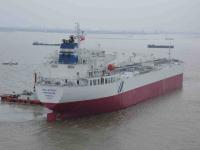
One million barrels of oil. Enough to fill more than 60 Olympic-sized swimming pools. And there it sat in tanks outside San Francisco — for three years — despite crude prices that topped $100 a barrel.
This isn’t the prized “light, sweet” kind of crude that is pumped out of the ground in Texas, or even the thick, sticky stuff from Alberta’s tar sands. Rather, it’s what’s known as “orphaned oil” that is so contaminated with organic chlorides that it can corrode the insides of even the biggest refineries.
Now, it’s on the move — and guessing exactly where is turning into a sort of parlor game for some in the oil market. All that is known is that Chevron Corp., which flushed the oil from a pipeline in September 2012 and has seen its value drop by $50 million since then, is loading it onto two tankers bound for Asia.
“It’s really kind of a bizarre incident,” said Gordon Schremp, a senior fuels specialist at the California Energy Commission who was notified by industry representatives of the planned exports.
It’s a rare shipment, considering most crude is barred from leaving U.S. borders. It just so happens that an exemption has been in place since 1992 allowing limited amounts of California oil to leave the country.
The only reason exports don’t happen very often is because California’s refiners keep almost all the state’s oil for themselves.
The saga began on Sept. 17, 2012, when Chevron told shippers that its pipeline delivering California crude to San Francisco-area refiners was contaminated. Chevron ended up pushing an estimated 1 million barrels through the pipe to get rid of the chlorides.
In Limbo
And so the tainted oil sat in tanks at a Plains All American Pipeline LP terminal in Martinez until this month, when all the red tape, including getting an export license from the Commerce Department, was finally cut, Schremp said.
When the contamination was discovered, heavy crude from California’s San Joaquin Valley cost $97 a barrel. It’s now $46. The difference, multiplied by 1 million barrels, is more than $50 million. And that’s not counting the cost of storing the oil for more than two years, which could add millions more.
West Texas Intermediate futures, the benchmark for U.S. crude, declined 40 cents to $56.75 a barrel on the New York Mercantile Exchange at 10:42 a.m. London time. Prices dropped 44 percent in the last year.
Kent Robertson, a spokesman for Chevron, declined to comment on the exports. Brad Leone and Meredith Hartley, spokesmen for Plains, didn’t respond to requests for comment.
Oil tanker Hellespont Protector, one of the two vessels chartered to carry the crude, was anchored in the San Francisco Bay on Friday, shipping data compiled by Bloomberg show. The other, Energy Champion, is headed for Qingdao, China, a place with no refineries. It may be a stopover, or it may not be headed to a refinery at all.
Fuel Oil
Schremp, who wasn’t told where the outcast barrels are headed, said they could be used as fuel for large ships or burned in a power plant.
If refiners know about the contamination ahead of time, they can blend in additives as a cure, but it’s an expensive solution that erodes the value of the crude, said David Hackett, president of energy consultant Stillwell Associates LLC in Irvine, California.
Wherever it lands, chances are it’ll be the first and last California oil that Asia sees for a while. California crude prices have been getting stronger and refiners across the Pacific have been flooded with supplies from much closer by.
Asked whether the rare cargoes are a bellwether for future exports of California oil, Schremp said, “It’s not like it makes perfect economic sense to move barrels that way into the world market — this was an export of circumstance.”
–With assistance from Sarita Williams in Houston and Naomi Christie in London.
©2015 Bloomberg News
![[ad-side]](http://www.crewing24.com/ad_images/65_banner.jpg)
![[ad-side]](http://www.crewing24.com/ad_images/110_banner.png)
![[ad-side]](http://www.crewing24.com/ad_images/95_banner.gif)
![[ad-side]](http://www.crewing24.com/ad_images/79_banner.jpg)
![[ad-side]](http://www.crewing24.com/ad_images/48_banner.jpg)
![[ad-side]](http://www.crewing24.com/ad_images/80_banner.jpg)
![[ad-side]](http://www.crewing24.com/ad_images/91_banner.png)
![[ad-side]](http://www.crewing24.com/ad_images/88_banner.jpg)
![[ad-side]](http://www.crewing24.com/ad_images/100_banner.jpg)
![[ad-side]](http://www.crewing24.com/ad_images/94_banner.png)